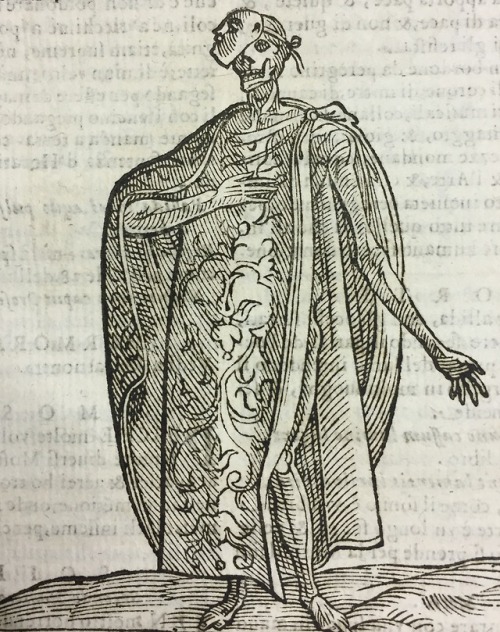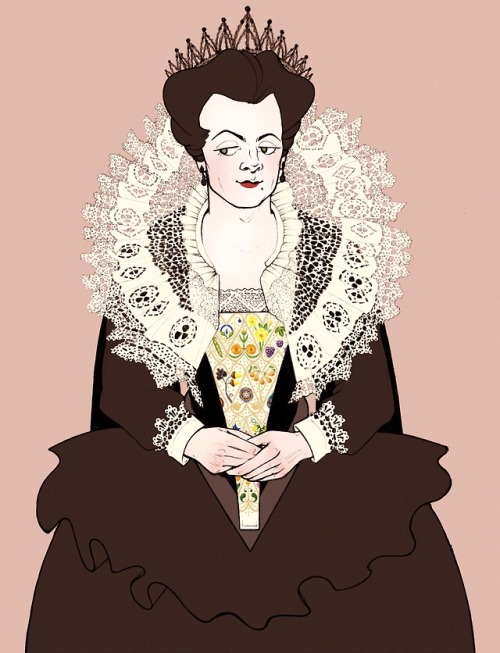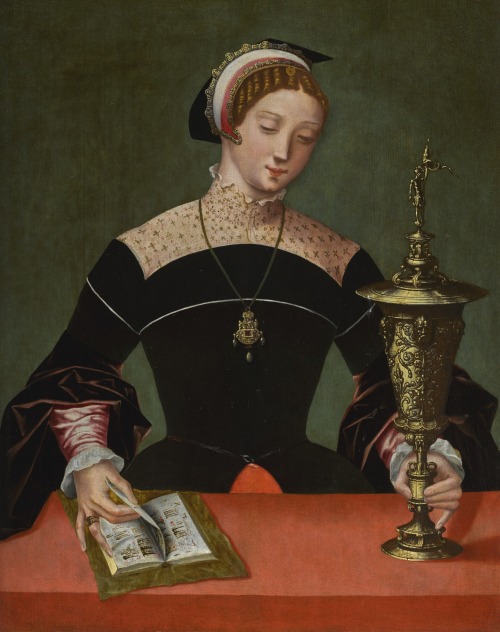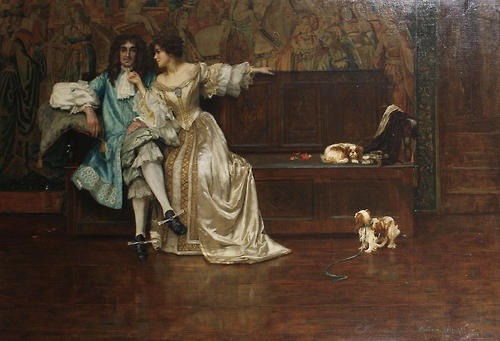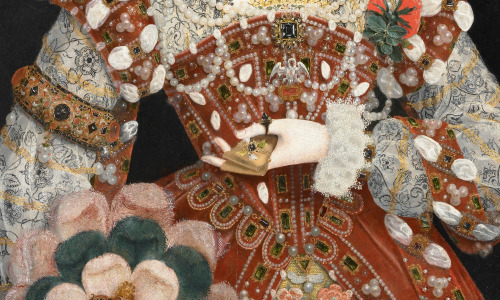#early modern
After looking through slideshows of last night’s Met Gala, I was determined to find a truly impressive outfit of the day in our special collections. But in my attempts to choose a favorite, I couldn’t decide between these three amazing hats from Wilson Library’s 1625 copy of Della novissime iconologie.
Whateveryour particular favorite Renaissance fashion look might be, it’s clear that all three of these early modern emblems are absolute style icons.
Post link
As you know, our librarians here at Wilson Library love finding all the mermaids in our special collections. So today, when we came across multiplemer-beings in our stacks, we knew we had to share them with our Tumblr followers.
These mer-men (and mer-creatures and mer-clergymen) were found in our Rare Books Collection’s copy of Physica Curiosa, a 17th century text dealing with a wide range of subjects including zoology, cryptozoology, obstetrical abnormalities, and demonology. Although Gaspar Schott includes all manner of centaurs, monster-chickens, wolf-men, and other oddities in Physica Curiosa, these mermaids are definitely our favorite cryptid of the book.
Post link
For Day 2 of #colorourcollections , we’ve decided to feature one of our favorite skeletons in Wilson Library Special Collections!
This particular skeleton is from De dissectione partium corporis humani libri tres(1545)–an anatomy text printed by the prolific printing family, the Estiennes.
Post link
BOOK REVIEW: Love’s Labour’s Lost by William Shakespeare
The university student is a strange creature, stuck in a curious limbo between adolescence and adulthood. It is said to be a time of great learning: you attend lectures on (hopefully) fascinating subjects, figure out how to pay an electricity bill, and do your own laundry. There is the pursuit of knowledge, the desire to evolve, a search for that elusive wisdom that all proper adults seem to possess… But you’re not an adult yet. Instead, you find yourself having water balloon fights outside the lecture hall and drunkenly debating the finer details of The Samurai Pizza Cats at a party while wearing a penguin suit you don’t remember putting on. This delicate balance between work and play, between newly-found responsibility and having fun, is exactly what Love’s Labour’s Lost is about.
Post link
Could anyone give me any advice?
I’m currently in my final year studying BA History and Politics, and am in the process of applying for a scholarship to study MA History of Medicine. For the application I need to write an diss proposal, it only needs to be a side of A4 and I have some ideas but no idea how to tell if they have potential or where to take them from here. If anyone has any advice or experience with these sorts of applications or with the field it would be amazing to run some ideas past you. Thanks!
redraw of an old sketch. very fun to get those embroidery details satisfactorily replicated! (and by ‘fun’ i mean i died and had to be resuscitated several times)
Post link
Japanese Bridges
“Depending upon the size and nature of the pond, gardens that include bodies of water with islands generally include bridges connecting the islands with the shore and often with each other. In the Heian Period and probably earlier, some of the bridges of the large boating ponds were arching structures of Chinese inspiration, allowing boats to pass beneath the spans. They could be built of either wood or stone (a wooden arched bridge is called sori bashi, a stone version sori ishibashi).
In later gardens, many of which have ponds that are too small for boats, bridges are often simple slabs of stone used singly or in combinations of two or three spans. These slabs are frequently natural, uncut stones, which together with the upright stones that usually flank the ends of the bridge should be considered part of the general "stone aesthetics” of a garden. In some instances, the bridge is actually part of a dry landscape, spanning only a sand or gravel stream. Other bridge types include simple wooden structures (kibashi) sometimes consisting of logs laid parallel to one another and supported on a truss-work frame, and more elaborate covered bridges that sometimes approach the scale of a pavilion.
The Chinese arched bridge (or “full moon bridge,” engetsukyo in Japanese) also survived into later periods and were sometimes employed in the same garden in which rustic slab bridges were found, but most of these have disappeared.“
Post link
Kanda House (built 19th century)
The Kanda family house is a typical “Gassho-zukuri” style house (a house built in the form of hands steepled in prayer). The house was established in the latter half of the Edo period by Wada Yaemon, the second son of the nearby Wada family (whose house is also a cultural treasure). At that time, the site of the present-day Kanda house was a rice field attached to Ubusuna Hachimangu Shrine. Accordingly, he changed his family name to “Kanda” (“Divine Rice Field”) in homage to the land’s former use. Subsequently, a house was constructed over a period of ten years by a master shrine carpenter from Ishikawa prefecture.
The upper stories of Gassho houses were commonly used for silkworm production, and Kanda house is no exception. The owners also made fuming nitric acid, an ingredient in the gunpowder of the time, as a commodity to trade for cash.
Post link

Madonna and Child in a Domestic Interior Artist: Painting by Manohar (active ca. 1582–1624) Object Name: Illustrated single work Date: early 17th century Geography: India Culture: Islamic Medium: Black and colored ink and gold on paper Dimensions: OveralL. 9 9/16 x 5 13/16in. (24.3 x 14.8cm) Dimensions of blue frame: 2 15/16 x 2 1/4in. (7.5 x 5.7cm) Dimensions of painting: 5 ¾ x 3 5/16in. (14.6 x 8.4cm) Classification: Codices Credit Line: Rogers Fund, 1970 Accession Number: 1970.217, Metropolitan Museum of Art
Notable Holy Roman Commanders in the War of the League of Cognac (1526-1530)
The Italians Wars as a whole mark some of the most chaotic times the region has experienced. The Italian states at the time were ravaged by consistent infighting, French and Holy Roman incursion, Papal attempts at dominance, and eventually Ottoman Turkish interference. This maelstrom of war lasted nearly 70 years and was characterised by intense bursts of conflict that devastated the region. Powerful commanders, however, were forged in the unforgiving crucible that was war-torn Italy and today I will be highlighting some from just this small segment in the entire overarching conflict.
The conflict began as a direct result of the French loss in the previous war (lasting from 1521-1525). The French had decisively lost at Pavia and Lombardy as a whole which prompted Pope Clement VIII to arrange a formal league led by the pride-damaged French but which also included the Republic of Florence, the Duchy of Milan, the Republic of Venice, and the Republic of Genoa. The Kingdom of England and Kingdom of Navarre played a small, but present role as well. Opposing this League was the Holy Roman Empire and its holdings in Spain and Sicily.
Here are some of the Holy Roman/Imperial German leaders in the War of the League of Cognac.

Alfonso d'Avalos, Marchese del Vasto. Painted by Titian in very early 1533. Housed in the J. Paul Getty Museum. Alfonso d’Avalos fought on the Imperial German side under Emperor Charles V and was appointed governor of Milan after it was seized from the Sforza family on the League’s side. He was commanded by Imperial Lieutenant of Naples, Don Hugo de Moncad, and was instrumental in the utter defeat of League forces outside of Naples in 1528. Further, for his actions he was inducted into the Order of the Golden Fleece.
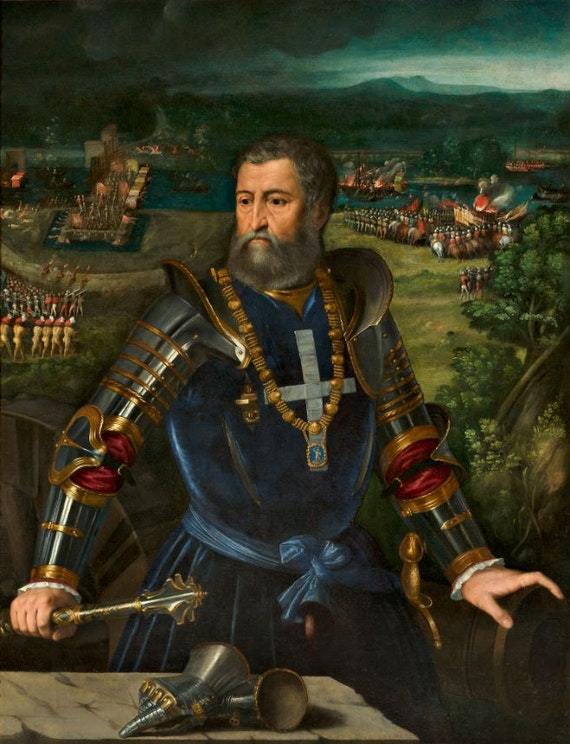
Alfonso I d'Este, Duke of Ferrara. Painted by Battista Dossi (the sibling of Dosso Dossi) between 1534-1536. Housed in the Gallerie Estensi. Alfonso I d’Este had a very poor relationship with the Papacy even before this war. In 1510, Pope Julius II had excommunicated d’Este to annex his territories into Papal control. d’Este had then gone on to fight against the Papacy in the previous wars and eventually sided with Emperor Charles V as the French wanted to validate Papal claims on Ferrara.

Charles III, Duke of Bourbon. Painted sometime in the 16th century by an unknown artist. Housed in the Parc & Château de Beauregard. Charles had fought for the French for most of his career as Constable, but had severe disagreements with his treatment by King Francis I. For this, Charles conspired against Francis and defected to the Imperial German forces in 1523. Charles received a very diverse army of Italians, Germans, and Spaniards but faced grave issues regarding payment of troops (many of whom were mercenaries) and issues around food supply. His failure to control his forces resulted in the marching to Rome where he was shot and killed outside the walls which then triggered the impromptu Sack of Rome in 1527.

Ferrante I Gonzaga. Painted sometime in the 16th century by an unknown artist. I could not locate where it is housed. Gonzaga succeeded Charles III de Bourbon and was promoted to commander-in-chief of the Imperial German forces in Italy. Further, he was captain-general of the Imperial light cavalry with which he ruthlessly harassed and ambushed League forces successfully for the entire campaign. His creative and bold use of light cavalry as a critical instrument of this new mobile warfare led to him becoming a knight of the Order of the Golden Fleece in 1531 and eventually governor of the Duchy of Milan. Gonzaga was part of the forces with the Prince of Orange that crushed League forces outside of Naples in 1528.



Three depictions of lovers/couples from the 17th century CE in Safavid Persia. All three reflect the growing acceptance of sensuality in art within the region, especially in regards to physical and emotional bonds. This trend seems to have begun in Isfahan.
The first (top left) was painted in A.H. 1039/1630 CE by Riza-yi ` Abbasi who was revolutionary in his usage of atypical palettes and calligraphic linework. It is currently housed in the MET.
The second (top right), signed by Haidar, is more ambiguously dated to either the 11th or 12th century A.H./17th century CE. It, like the first, is housed at the MET.
The last was painted in A.H. 1098/1689 CE in the style of Mu'in Musawwir. It is currently housed at the Walters Art Museum.

Marie-Guillemine Benoist (French,1768 - 1826)
Portrait of a Lady, ca. 1799
San Diego Museum of Art, San Diego, California, United States of America

Attributed to Caterina van Hemessen (1528 - after 1587)
Portrait of a Young Lady, ca. 1560
Baltimore Museum of Art, Baltimore, United States of America

Margareta de Heer (Dutch, ca. 1600 - before 1665)
Diana, Bespied door een Sater, ca. 1655
Fries Museum, Leeuwarden, The Netherlands

Margareta de Heer (Dutch, 1600 - before 1665)
Boerenerf met Spinnende Vrouw, ca. 1650
Private collection
This election should not surprise anyone who teaches history. I teach medieval and early modern history at several unis in London.
The study of history in these eras shows us very clearly that Western society is built for white male protestant property owners.
This same society has been built over the bodies of black and brown people, and kept whites without property deliberately marginalised. Within it, the role of women has always been to be scapegoats for the worst of male excess, and vessels for sexual gratification/the getting of heirs.
You should not, therefore, be surprised to see a misogynist racist ruling what has always been a white supremacist society.
As historians, it is our job to show our students the roots of this society - SHOW them the thought processes that have built our world.
Today I am teaching two seminars - one on courtly love, one on the rise of Protestantism.
So - for courtly love we are going to discuss how noble society built a) the concept of women as objects to be admired and desired and b) we’ll talk about the concept of upper class men being entitled to the bodies of lower class women. I’ve talked about the concept of courtly love, the rape of poor women and Trump before here, of course, and we’ll expand on that.
We’ll also talk about how this concept plays out in pop culture, and how we romanticise the *idea* of women, but hate their sexual autonomy. In particular we’ll talk, like I have on this blog, about Hot Line Bling, and how Drake reuses concepts of courtly love. We’ll talk about how society is still pushing for a quiet, sexually cowed woman to be controlled by more powerful men, not only in the realm of politics, but in pop culture.
We’ll talk about how it has ALWAYS been this way and that electing a man who brags about dominating women is nothing new.
In my early modern class I am teaching the Reformation. We will use this as an opportunity to discuss the glorification of the individual white male and his theoretical ability to speak for God.
The Reformation argues for the ability of individual white males to interpret the Bible for themselves, and therefore God’s will. Granted, before the Reformation the Church - a group of white males - interpreted God’s words. After the Reformation, however, every individual white man is told that he has the wherewithal to understand God, with or without training.
That no one needs to be educated and learn to interpret allegory is underscored by a movement away from Latin. Latin needs to be taught to people. In the vernacular, any uneducated person can read the Bible, and interpret it for themselves. In the Reformation we see the enshrining of the individual uneducated white male’s opinion. White men now speak for God. What is more, white men don’t need to speak any language other than their own. There is no need to find common ground with others.
We are all just living in the continuation of this world. A world that is built around the lionisation of mediocre white men with money. This is our job as historians - to show this. To show our students how we got here and how we are STILL here.
If you haven’t been connecting the study of history to the present day with your students, you’ve been doing it wrong. Those who study history are unsurprised by Trump’s election, and the racism and sexism in America, because it was always there. It has always and ever been present in the Western world as a whole, and is on even further display in a country which was created to enshrine the desires of a group of slave-holding white men.
Go wake your students up. Teach them the history, point them in the direction of things like the Ferguson Syllabus. Give them the tools. This is our job. This is the work. History matters. Tell your students how the world was made this way, and how they can change it.
(This post is a re-condensed tweetstorm. Interested parties can get this stuff 140 characters at a time here.)


